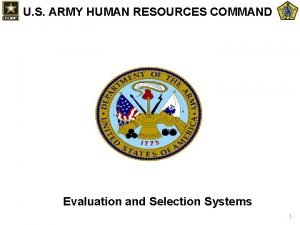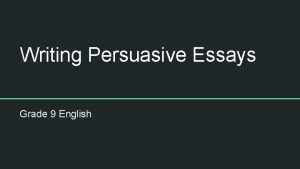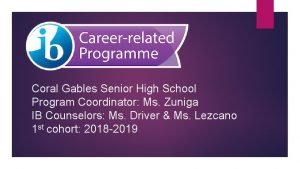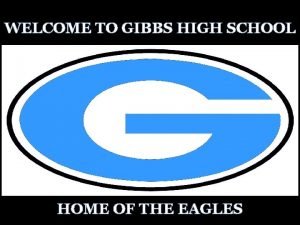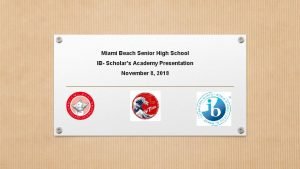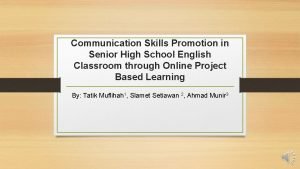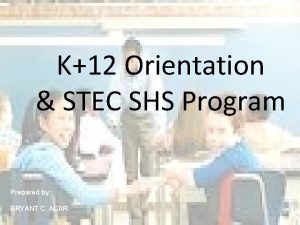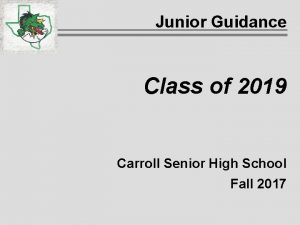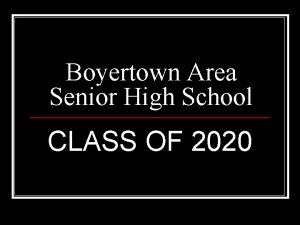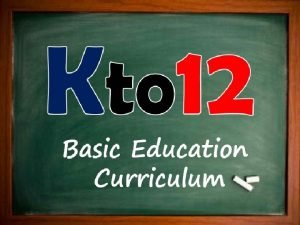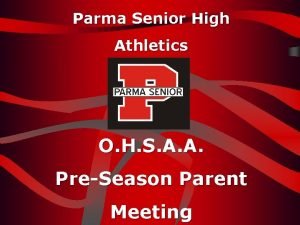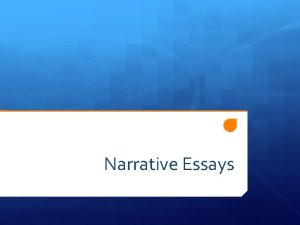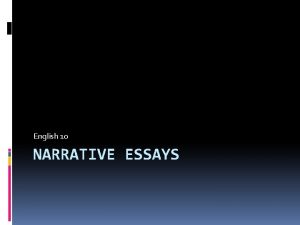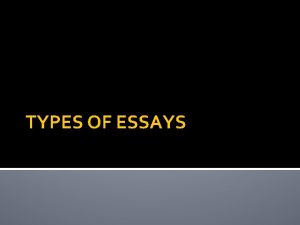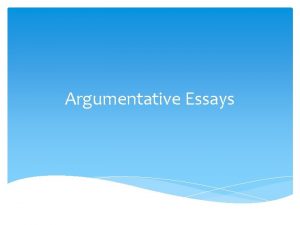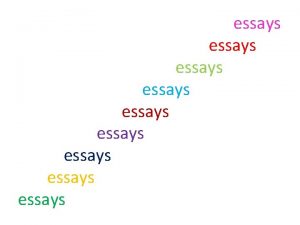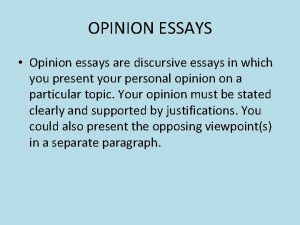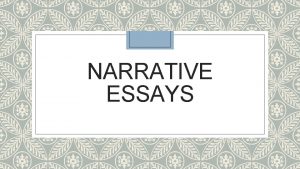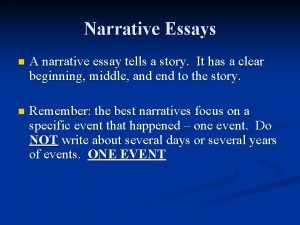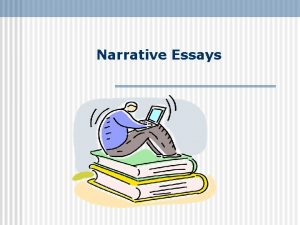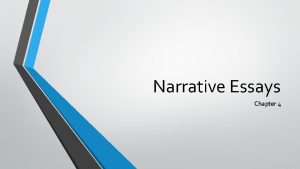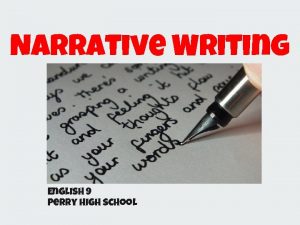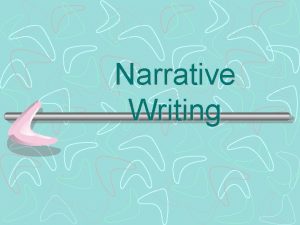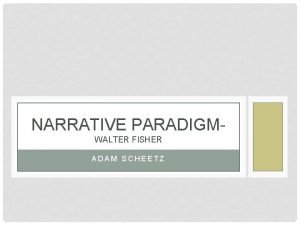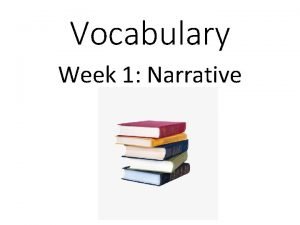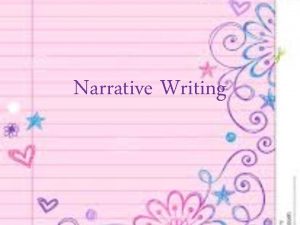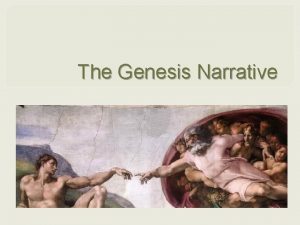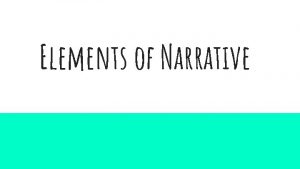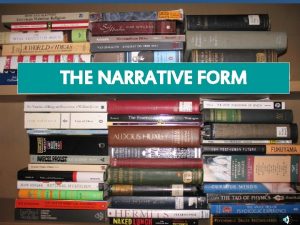Essays Senior High English Types of Essays Narrative





































- Slides: 37

Essays Senior High English

Types of Essays � Narrative – has a purpose for telling; a true event; a single incident � Memoir - a person’s story about his or her life � Descriptive - writing that creates images of people, places, objects � Argumentative – a rational argument which uses evidence � Persuasive - writing that attempts to convince the audience to adopt a certain point of view or to act in a certain way

5 Types of Expository Essays Expository essays are characterized on the basis of their method of development: � Example and Illustration � Cause and Effect � Classification and Division � Process Analysis � Comparison and/or Contrast

Method of Organization Expository Essay: general to specific �a thesis in an expository essay is supported with arguments, examples � Introduction, body paragraphs, and conclusion

Method of Organization Narrative Essay: � organized by sequence of events � chronological (time order)

Method of Organization Descriptive Essay: � Spatial - space ( i. e your favourite place) ◦ where the eye moves: up, down, over, across, under, etc. ) � Dominant impression: overall description of an object, place, etc. ◦ i. e. My car is a jalopy, but I love it. ◦ The bedroom is a dump. I think I have carpet under the piles of clothes and junk.

Purpose: The Reason for Writing � Remember the three “E’s” ◦ To explain ◦ To educate ◦ To entertain ◦ ◦ To To inform analyze tell a story describe AND

Audience �A writer’s purpose is often shaped by the kind of audience they are writing for: ◦ ◦ ◦ ◦ Young people Parents Government Daycare workers Store owners Consumers Avoid “everyone” – try to be specific

Thesis Statement � The overall idea of the essay containing the writer’s main through in sentence form. � Should be expressed in one or two sentences

Topic Sentence � The topic sentence does for a paragraph what a thesis does for a complete essay. � Expresses the main idea contained in the paragraph � It is often placed as the first sentence in the paragraph

Voice � The personality of the speaker or the author (persona), coming through in a work, , created through a combination of diction, point of view, and tone.

Tone � The author's attitude towards his topic and/or audience. � Although an author may directly state this attitude it is more likely to be implied. � Tone is considered formal or informal; personal or impersonal

Tone The tone is implied through: � the author's diction (word choice) � through the connotation (what a word suggests beyond its dictionary meaning) � and from sentence structure i. e. long sentences suggest a serious or more formal tone

Examples of Tone � Angry � Sympathetic � Sarcastic � Sentimental � Silly � Pitiful � Sad � Afraid � Happy � Sharp � Cold � Happy � Detached � Cynical � Upset � Joking � Wonderment � Childish � Confused � Humorous � Thoughtful � Apologetic � Joyful � Sweet � Objective � Disgust � Mocking � Bitter � Arrogance � Vexed � Nostalgic � Horrific � Proud � Furious

Style: Informal � Slang � Colloquialisms –sayings common to a culture � plain language of everyday use � idiomatic expressions � – ace up your sleeve; above board; cut the apron strings � Contractions – can’t; won’t; I’ll � many simple, common words.

Style: Formal � Writer uses dignified, serious, and elevated language; � Follows the rules of syntax exactly � Uses complex words and lofty tone.

Unity � Unity – refers to the tying together of ideas to connect to thesis � Oneness in writing

How Unity is Achieved: � Clear thesis statement � Each part of the essay relates to thesis � Generalizations are supported with evidence – use of examples � Topic sentences in body paragraphs relate to thesis � Types of closings

Unity and Types of Closings: � Summary � Thesis restatement � Closing by return

Unity in Specific Types of Essays Expository essay – Descriptive essay – Narrative essay – single focus dominant impression concentration on a single story

Coherence � The arranging of ideas in logical order to show relationships between ideas through the use of the following main writing techniques: 1. 2. 3. 4. 5. Transitional Terms Pronoun Reference Repetition of Key Words Use of Synonyms Parallel Structure

1. Transitions � Words, phrases, or even sentences used to show the relationship between ideas ◦ in a sentence ◦ within a paragraph ◦ between paragraphs Transitions help to achieve unity and coherence.

Examples of Transitions �A good education is important for a number of reasons. First, it broadens your mind. Second, you learn new things. Finally, you prepare for the future.

Examples of Transitions like autumn, and yet autumn is a sad time of the year, too. The leaves turn bright shades of red and the weather is mild, but I can't help thinking ahead to the winter and the ice storms that will surely blow through here. In addition, that will be the season of chapped faces, too many layers of clothes to put on, and days when I'll have to shovel heaps of snow from my car's windshield. �I

Transitions To Add: and, again, and then, besides, equally important, finally, furthermore, moreover, in addition, first (second, etc. ), To Compare: but, yet, on the other hand, however, nevertheless, on the other hand, on the contrary, by comparison, compared to, balanced, although, conversely, meanwhile, after all, in contrast, although this may be true To Prove: because, for, since, for the same reason, obviously, evidently, furthermore, moreover, besides, indeed, in fact, in addition To Show Time: immediately, thereafter, soon, after a few hours, finally, then, later, previously, formerly, first (second, etc. ), next, and then To Emphasize: definitely, obviously, in fact, indeed, in any case, absolutely, positively, naturally, unquestionably, without a doubt, certainly, undeniably, without reservation To Show Sequence: first, second, third, and so forth. following this, at this time, now, at this point, afterward, subsequently, finally, consequently, previously, thus, therefore, hence, next, and then, soon To Give an Example: for example, for instance, in this case, take the case of, to demonstrate, to illustrate, as an illustration, to illustrate To Summarize or Conclude: in brief, on the whole, summing up, to conclude, hence, therefore, accordingly, thus, as a result, consequently

2. Pronoun Reference This, that, these, those, he, she, it, they, we � are useful pronouns for referring back to something previously mentioned. Example: When scientific experiments do not work out as expected, they are often considered failures until some other scientist tries them again. Those that work out better the second time around are the ones that promise the most rewards.

3. Repetition � helps track. to focus ideas and to keep the reader on Example: The problem with contemporary art is that it is not easily understood by most people. Contemporary art is deliberately abstract, and that means it leaves the viewer wondering what she is looking at.

4. Use of synonyms Synonyms words that have essentially the same meaning, and they provide some variety in word choice, helping the reader to stay focused on the idea being discussed. Example: Myths narrate sacred histories and explain sacred origins. These traditional narratives are, in short, a set of beliefs that are a very real force in the lives of the people who tell them.

5. Parallel Structure � using the same pattern of words to show that two or more ideas have the same level of importance. ◦ This can happen at the word, phrase, or sentence level. Example: Mary likes to hike, to swim, and to ride a bicycle. The coach told the players that they should get a lot of sleep, that they should not eat too much, and that they should do some warm-up exercises before the game.

Openings 7 different types of openings: 1. 2. 3. 4. 5. 6. 7. Anecdote – brief story Shocking statistic Question Quotation Brief description A personal example Definition

Closings � Call to action (for persuasive essays) � Thesis restatement – thesis is reworded � Closing by return – the writer refers to something from the opening � Summary – a main point or two from each body paragraph

Sentence Fluency � writers achieve coherency with effective use of sentences.

Short Sentences Short sentences: (and sentence fragments – incomplete thoughts, phrases) � Speed up a piece of writing – rapid movement � Create tension – anxiety, fear, excitement � Used for emphasis - identify what is being stressed

Long Sentences � Develop more complex ideas � Serious description � Formal writing

Diction = author’s word choice � Examine the dictionary meaning of words – denotation � Figure out the implied meaning or the connotation

Diction There is no single, correct diction in the English language; instead, you choose different words or phrases for different contexts: To To a friend "a screw-up" a child "a mistake" the police "an accident" an employer "an oversight”

Rhetorical Question � It is not a question to be answered. It is used to: ◦ Launch or further discussion ◦ Capture interests of the audience ◦ Identify the topic; often focuses on the central idea or topic ◦ To get the reader thinking about the topicx
 Evaluation entry system
Evaluation entry system Persuasive essay topics for grade 9
Persuasive essay topics for grade 9 Scarborough senior high school
Scarborough senior high school Gearing up for the future (senior high school)
Gearing up for the future (senior high school) Dayuan international senior high school
Dayuan international senior high school Chatsworth senior high
Chatsworth senior high Alonzo tracy mourning high school
Alonzo tracy mourning high school Children who release unexpressed anger
Children who release unexpressed anger Paul d schreiber high school
Paul d schreiber high school Aice diploma requirements florida
Aice diploma requirements florida Senior high school subjects per semester
Senior high school subjects per semester A&d strand
A&d strand Miami sunset high school
Miami sunset high school Requirements for erf t2
Requirements for erf t2 Strand in senior high
Strand in senior high Coral gables senior high
Coral gables senior high Gibbs senior high school
Gibbs senior high school Chatsworth charter high school
Chatsworth charter high school Naviance potomac senior high school
Naviance potomac senior high school Miami beach senior high scholars program
Miami beach senior high scholars program Satisfaction level of students in senior high school
Satisfaction level of students in senior high school Kalamunda senior high school
Kalamunda senior high school Communication skills of senior high school students
Communication skills of senior high school students Welcome to your senior year of high school
Welcome to your senior year of high school Shippensburg area senior high school
Shippensburg area senior high school Miami killian senior high school rating
Miami killian senior high school rating Strand shs
Strand shs Carroll senior high school counselors
Carroll senior high school counselors Boyertown senior high school
Boyertown senior high school Westshore junior senior high school
Westshore junior senior high school Palace senior high school
Palace senior high school What is basic education
What is basic education Senior high school subjects (per semester)
Senior high school subjects (per semester) Scope and limitations of study example
Scope and limitations of study example Parma senior high
Parma senior high Osbourn park senior high school
Osbourn park senior high school Fairfield senior high school
Fairfield senior high school Vocational senior high school
Vocational senior high school
